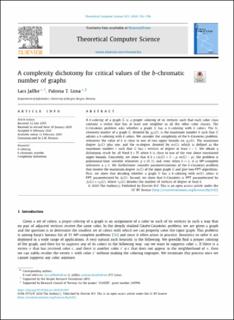A complexity dichotomy for critical values of the b-chromatic number of graphs
Journal article, Peer reviewed
Published version

Åpne
Permanent lenke
https://hdl.handle.net/11250/2758155Utgivelsesdato
2020Metadata
Vis full innførselSamlinger
- Department of Informatics [928]
- Registrations from Cristin [9791]
Sammendrag
A b-coloring of a graph G is a proper coloring of its vertices such that each color class contains a vertex that has at least one neighbor in all the other color classes. The b-Coloring problem asks whether a graph G has a b-coloring with k colors. The b-chromatic number of a graph G, denoted by χb(G), is the maximum number k such that G admits a b-coloring with k colors. We consider the complexity of the b-Coloring problem, whenever the value of k is close to one of two upper bounds on χb(G): The maximum degree (G) plus one, and the m-degree, denoted by m(G), which is defined as the maximum number i such that G has i vertices of degree at least i −1. We obtain a dichotomy result for all fixed k ∈N when k is close to one of the two above mentioned upper bounds. Concretely, we show that if k ∈{ (G) +1 −p, m(G) −p}, the problem is polynomial-time solvable whenever p ∈{0, 1} and, even when k =3, it is NP-complete whenever p ≥2. We furthermore consider parameterizations of the b-Coloring problem that involve the maximum degree (G) of the input graph G and give two FPT-algorithms. First, we show that deciding whether a graph G has a b-coloring with m(G) colors is FPT parameterized by (G). Second, we show that b-Coloring is FPT parameterized by (G) + k(G), where k(G) denotes the number of vertices of degree at least k.
